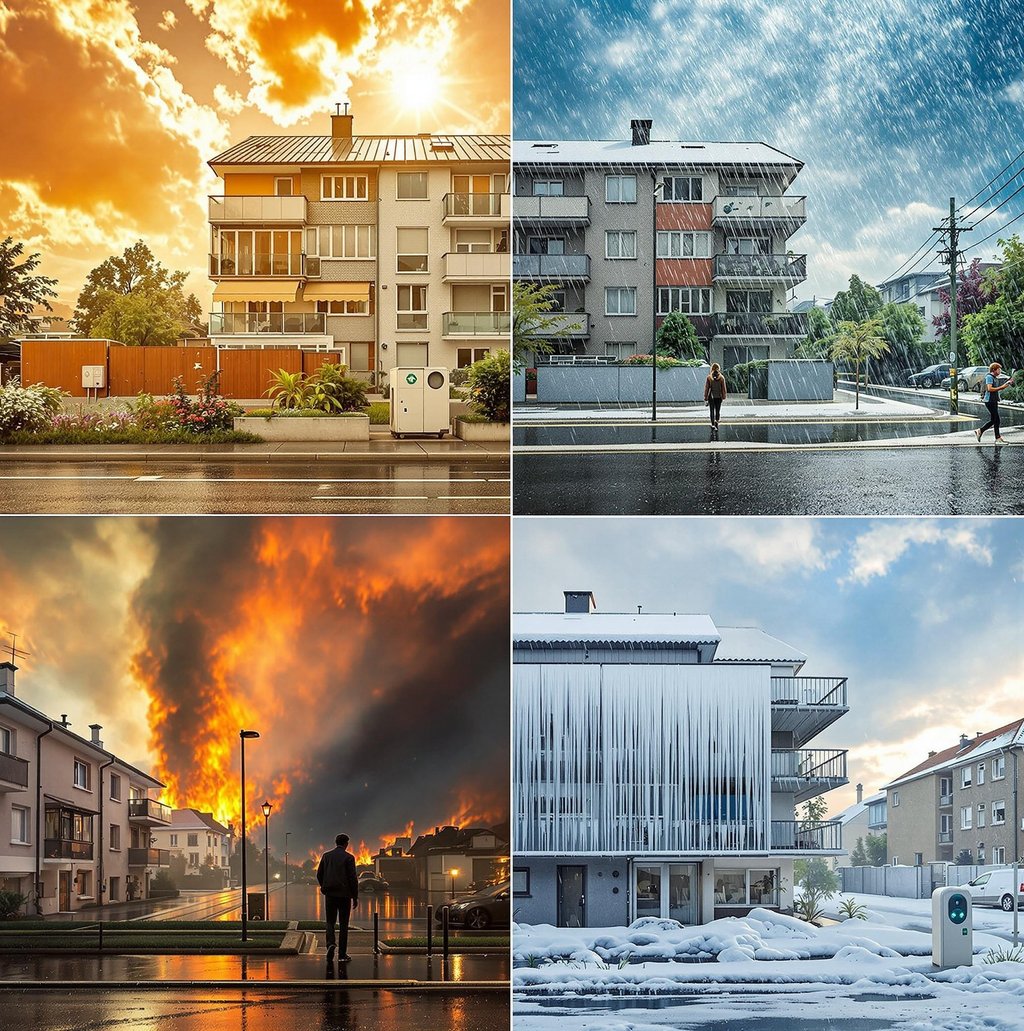Quality and technology IN CONSTRUCTION
delivered with STRAIGHT communication
Climate-Resilient Architecture – From Heat Waves to Wildfires: How Do We Build Cities That Survive?
The article explains, in a nutshell, how a typical 1980s apartment block can be retrofitted to survive heatwaves, floods, wildfires and ice storms using affordable, readily available solutions.
CONSTRUCTIONTRENDPROJECTMANAGEMENTSUSTAINABILITYFUTURE
Dr. Toldy Gábor - Toldy Construct
7/11/20253 min read


Climate-Resilient Architecture – From Heat Waves to Wildfires: How Do We Build Cities That Survive?
1. The Last Hours of the Old Status Quo
The record-breaking heat waves of 2024–25, flash-flood events, and wildfires from California to Greece have made one truth unavoidable: mitigation-only architecture has failed. Climate change is now a design parameter, not background noise. TIME reports that the market for “adaptive, disaster-proof” buildings is growing 8–10 % a year, while insurers increasingly refuse to cover conventional homes. As British architect Mark Muir bluntly notes: “Resilience is no longer a feature—it’s standard equipment.”
2. Urban Heat Islands: Cool-Roof + Green-Roof Hybrids
Recent Brazilian and Chinese studies show that hybrid green- and reflective roofs lower roof-surface temperatures by 3–5 °C and save 18–26 % annual energy. New York’s green-roof incentives and Gujarat State’s “cool-roof” pilot prove the concept works even in low-income housing: a simple white coating cooled interiors by 5 °C and cut electricity use by 17 %. Research into zig-zag façade textures adds another passive 3 °C of cooling—yet in winter they leak heat, so they must be paired with heat-adaptive façade technology.
Critical note: high-albedo coatings lose 25–30 % of their effectiveness within 5–7 years because of soiling—an Achilles heel most LCA studies overlook.
3. Flood Protection – When Water Is a Design Constant, Not an Enemy
In Pakistan, architect Yasmeen Lari has built one million flood-proof bamboo-and-mud houses, using floating foundations and rapidly deployable modular levees. In Europe, Danish firm MAST creates floating neighborhoods on modular grids that remain stable as water levels rise. On the research front, a Flood Adaptive Platform steel-frame house lifts hydraulically off its foundation, staying dry through 45 cm of surge.
Watch out: Modular levees like the Stingray Self-Rising Water Dam install quickly, but their Achilles heel is storage and maintenance—highlighted by a Canadian Coast Guard test on a 900-m stretch.
4. Wildfire-Proof Homes: Treating Fire as a Design Partner
The IBHS Wildfire Prepared Home standard (2025 update) mandates precise, testable details: Class A roofing, non-combustible eaves, a 1.5-m gravel buffer. In Southern California, KB Home is already building entire wildfire-ready subdivisions—houses spaced 3 m apart with 3-mm ember-screening on every vent. Santa Barbara’s Resilient House, clad in perforated metal, survived 30 minutes of direct flame with zero damage.
Critique: These solutions still largely target wealthier suburbs; without community-scale fire breaks, protection remains a patchwork.
5. Dynamic Heat-Adaptive Façade Systems
A recent ScienceDirect paper presented a double-skin façade filled with phase-change material (PCM) that shaved peak cooling load by 11 % in Western Europe. A 2025 MDPI review found that moving louver, ventilative, and PV-shading hybrids can save 30–45 % primary energy. Freiburg’s livMatS research building uses 4-D-printed cellulose louvers that open with humidity and close in winter, trimming HVAC demand by 9 % annually.
6. Material and Sensor-Tech Innovations
PCM-coated roofs store 35–40 % of daytime cooling load, but only in climates with nighttime lows under 20 °C.
Smart flood sensors trigger “plug-and-play” levees the moment water rises 30 cm above a threshold.
Adaptive solar louvers from ETH Zürich’s Adaptive Solar Façade both shade and generate power.
7. Financial Reality vs. Greenwashing
The World Economic Forum pegs the global adaptation gap at $212 billion per year—yet every preventive dollar avoids $4–8 in future damage. In the U.S., insurers already discount premiums 15–20 % for projects certified as climate-resilient design. In Hungary, by contrast, even “near-zero” codes are patchy, and 32 % of cool-roof grant schemes collapsed under red tape—Unsustainable Magazine finds.
8. Conclusion – Resilience Is the New Currency
Climate-resilient design isn’t an eco-trend; it’s a competitive strategy. Deploy heat-adaptive façades, flood-proof foundations, and wildfire-ready details in concert, and you not only save lives—you create stable, appreciating assets. As Gábor Toldy puts it: “The built environment earns its right to exist only if it survives the climate that threatens its own lifespan.”
Construction
With over 20 years of experience in general contracting, our company specializes in the flawless execution of unique, bespoke buildings. Our innovative methods and mindset make us stand out in the market.
Our services
Contacts
company@toldyconsult.hu
+36 30 289 2383
© 2024. All rights reserved.
Our WEBPAGES
www.toldyconsult.hu
